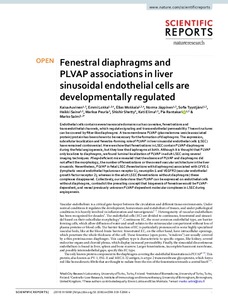Fenestral diaphragms and PLVAP associations in liver sinusoidal endothelial cells are developmentally regulated
Markus Peurla; Sofia Tyystjärvi; Norma Jäppinen; Elias Mokkala; Heikki Saine; Pia Rantakari; Kaisa Auvinen; Emmi Lokka; Marko Salmi; Shishir Shetty; Kati Elima
Fenestral diaphragms and PLVAP associations in liver sinusoidal endothelial cells are developmentally regulated
Markus Peurla
Sofia Tyystjärvi
Norma Jäppinen
Elias Mokkala
Heikki Saine
Pia Rantakari
Kaisa Auvinen
Emmi Lokka
Marko Salmi
Shishir Shetty
Kati Elima
NATURE PUBLISHING GROUP
Julkaisun pysyvä osoite on:
https://urn.fi/URN:NBN:fi-fe2021042824159
https://urn.fi/URN:NBN:fi-fe2021042824159
Tiivistelmä
Endothelial cells contain several nanoscale domains such as caveolae, fenestrations and transendothelial channels, which regulate signaling and transendothelial permeability. These structures can be covered by filter-like diaphragms. A transmembrane PLVAP (plasmalemma vesicle associated protein) protein has been shown to be necessary for the formation of diaphragms. The expression, subcellular localization and fenestra-forming role of PLVAP in liver sinusoidal endothelial cells (LSEC) have remained controversial. Here we show that fenestrations in LSEC contain PLVAP-diaphragms during the fetal angiogenesis, but they lose the diaphragms at birth. Although it is thought that PLVAP only localizes to diaphragms, we found luminal localization of PLVAP in adult LSEC using several imaging techniques. Plvap-deficient mice revealed that the absence of PLVAP and diaphragms did not affect the morphology, the number of fenestrations or the overall vascular architecture in the liver sinusoids. Nevertheless, PLVAP in fetal LSEC (fenestrations with diaphragms) associated with LYVE-1 (lymphatic vessel endothelial hyaluronan receptor 1), neuropilin-1 and VEGFR2 (vascular endothelial growth factor receptor 2), whereas in the adult LSEC (fenestrations without diaphragms) these complexes disappeared. Collectively, our data show that PLVAP can be expressed on endothelial cells without diaphragms, contradict the prevailing concept that biogenesis of fenestrae would be PLVAP-dependent, and reveal previously unknown PLVAP-dependent molecular complexes in LSEC during angiogenesis.
Kokoelmat
- Rinnakkaistallenteet [19250]
